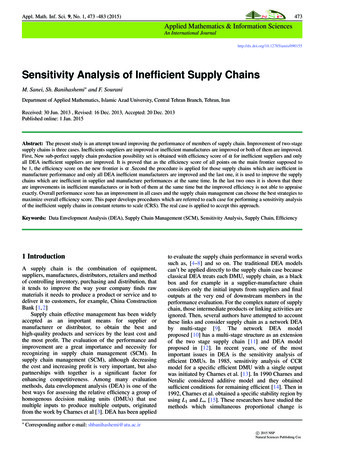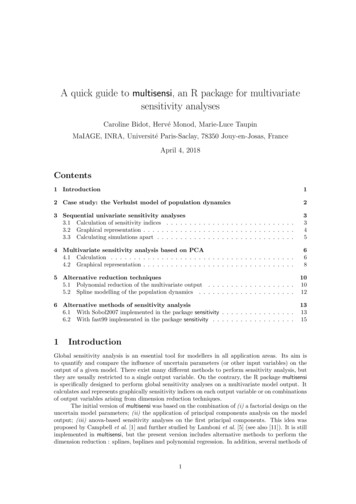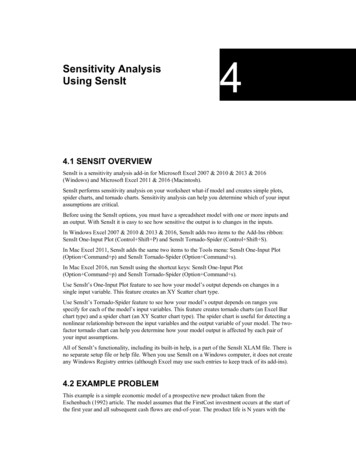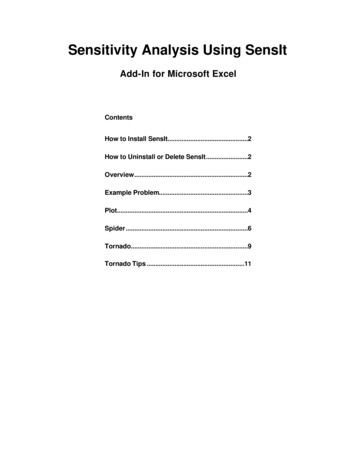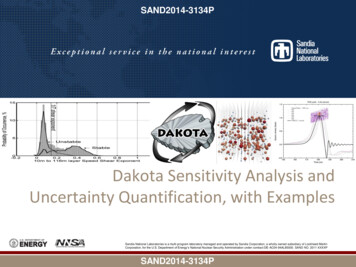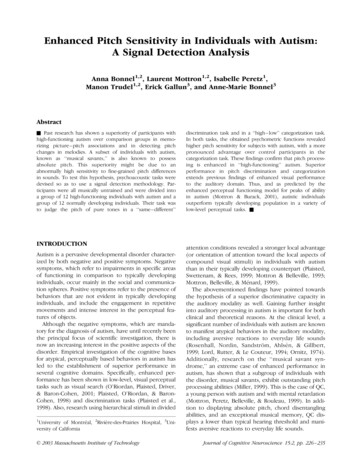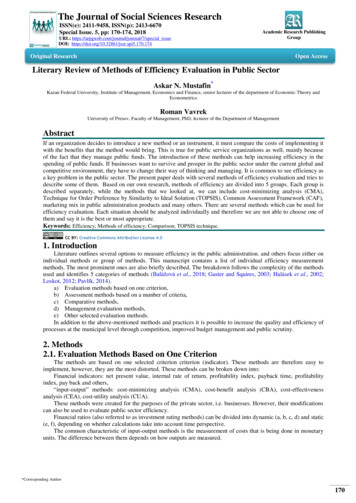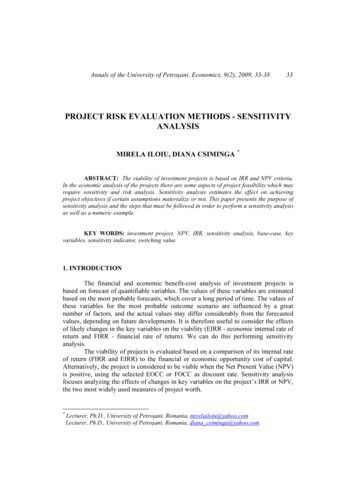
Transcription
Annals of the University of Petroşani, Economics, 9(2), 2009, 33-3833PROJECT RISK EVALUATION METHODS - SENSITIVITYANALYSISMIRELA ILOIU, DIANA CSIMINGA *ABSTRACT: The viability of investment projects is based on IRR and NPV criteria.In the economic analysis of the projects there are some aspects of project feasibility which mayrequire sensitivity and risk analysis. Sensitivity analysis estimates the effect on achievingproject objectives if certain assumptions materialize or not. This paper presents the purpose ofsensitivity analysis and the steps that must be followed in order to perform a sensitivity analysisas well as a numeric example.KEY WORDS: investment project, NPV, IRR, sensitivity analysis, base-case, keyvariables, sensitivity indicator, switching value1. INTRODUCTIONThe financial and economic benefit-cost analysis of investment projects isbased on forecast of quantifiable variables. The values of these variables are estimatedbased on the most probable forecasts, which cover a long period of time. The values ofthese variables for the most probable outcome scenario are influenced by a greatnumber of factors, and the actual values may differ considerably from the forecastedvalues, depending on future developments. It is therefore useful to consider the effectsof likely changes in the key variables on the viability (EIRR - economic internal rate ofreturn and FIRR - financial rate of return). We can do this performing sensitivityanalysis.The viability of projects is evaluated based on a comparison of its internal rateof return (FIRR and EIRR) to the financial or economic opportunity cost of capital.Alternatively, the project is considered to be viable when the Net Present Value (NPV)is positive, using the selected EOCC or FOCC as discount rate. Sensitivity analysisfocuses analyzing the effects of changes in key variables on the project’s IRR or NPV,the two most widely used measures of project worth.*Lecturer, Ph.D., University of Petroşani, Romania, mirelailoiu@yahoo.comLecturer, Ph.D., University of Petroşani, Romania, diana csiminga@yahoo.com
34Iloiu, M.; Csiminga, D.In the economic analysis of the projects, there are also other aspects of projectfeasibility which may require sensitivity analysis. These include:1. demand analysis: to assess the sensitivity of the demand forecast to changes inpopulation growth, per capita consumption, prices, etc.2. least cost analysis: to verify whether the selected least-cost alternative remains thepreferred option under adverse conditions3. sustainability analysis: to assess possible threats to the sustainability of the project4. distributional analysis: to analyse whether the project will actually benefit the poor.Sensitivity analysis is particularly concerned with factors and combinations offactors that may lead to unfavourable consequences. These factors would normallyhave been identified in the project (logical) framework as „project risks” or “projectassumptions”. Sensitivity analysis tries to estimate the effect of achieving projectobjectives if certain assumptions do not, or only partly, occur.2. THE PURPOSE OF SENSITIVITY ANALYSISSensitivity analysis is a technique for investigating the impact of changes inproject variables on the base-case (most probable outcome scenario). Typically, onlyadverse changes are considered in sensitivity analysis. The purpose of sensitivityanalysis is:1. to help identify the key variables which influence the project cost and benefitstreams2. to investigate the consequences of likely adverse changes in these key variables3. to assess whether project decisions are likely to be affected by such changes4. to identify actions that could mitigate possible adverse effects on the project.3. PERFORMANCE OF SENSITIVITY ANALYSISSensitivity analysis needs to be realized in a systematic manner. To meet theabove purposes, the following steps are recommended to be followed:1. identify key variables to which the project decision may be sensitive2. calculate the effect of likely changes in these variables on the base-case IRR orNPV, and calculate a sensitivity indicator and/or switching value3. consider possible combinations of variables that may change simultaneously in anadverse direction4. analyze the direction and scale of likely changes for the key variables identified,involving identification of the sources of change.Step 1: Identifying the key variables. The base case project economicanalysis incorporates many variables: quantities and their inter-relationships, prices oreconomic values and the timing of project effects. Some of these variables will bepredictable or relatively small in value in the project context. It is not necessary toinvestigate the sensitivity of the measures of project worth to such variables. Othervariables may be less predictable or larger in value. Variables related to sectorial policyand capacity building may also be important. As they are more difficult to quantify,they are not further considered hereafter but should be assessed in a qualitative manner.
Project Risk Evaluation Methods - Sensitivity Analysis35As a result of previous experience (from post-evaluation studies) and analysis of theproject context, a preliminary set of likely key variables can be chosen on thefollowing basis:1. variables which are numerically large, ex. investment cost2. essential variables, which may be small, but the value of which is very importantfor the design of the project3. variables occurring early in the project life, ex. investment costs and initial fixedoperating costs, which will be relatively unaffected by discounting4. variables affected by economic changes, such as, changes in real income.Table 1. Base Case of an Investment O&MNet 661061505566610615055666106150556661061505Step 2 and 3: Calculation of effects of changing variables. The values of thebasic indicators of project viability (EIRR and ENPV) should be recalculated fordifferent values of key variables. This is preferably done by calculating sensitivityindicators and switching values. The meaning of these concepts is presented in table 2as well as a sample calculation.Table 2. Use of Sensitivity Indicators and Switching ValuesDefinitionExpressionSensitivity Indicators1.Towards the Net Present ValueCompares percentage change in NPV withpercentage change in a variable orcombination of variables.Switching Value1. Towards the Net Present Value Thepercentage change in a variable orcombination of variables to reduce the NPVto zero.2. Towards the Internal Rate of Return.Compares percentage change in IRRabove the cut-off rate with percentagechange in a variable or combination ofvariables.1.Towards the Net Present Value(NPVb – NPV1) / NPVbSI --------------------------------(Xb – X1) / Xbwhere:Xb – value of variable in the base caseX1 – value of the variable in the sensitivitytestNPVb – value of NPV in the base caseNPV1 – value of the variable in thesensitivity test2. Towards the Internal Rate of Return.The percentage change in a variable orcombination of variables to reduce the IRR tothe cut-off rate ( discount rate).1.Towards the Net Present Value(100 x NPVb)(Xb – X1)SV ---------------------- x ------------(NPVb – NPV1)Xbwhere:Xb – value of variable in the base caseX1 – value of the variable in the sensitivitytestNPVb – value of NPV in the base caseNPV1 – value of the variable in the sensitivitytest
oiu, M.; Csiminga, D.2.Towards the Internal Rate of Return2.Towards the Internal Rate of Return(IRRb – IRR1) / (IRRb – d)SI ---------------------------------(Xb – X1) / Xb(100 x NPVb)(Xb – X1)SV ---------------------- x ------------Xb(NPVb – NPV1)where:Xb – value of the variable in the base caseX1 – value of the variable in the sensitivitytestIRRb – value of IRR in the base caseIRR1 – value of the variable in thesensitivity testd – discount rate1.Towards the Net Present ValueBase Case:Price Pb 300NPVb 20,912Scenario 1:P1 270 (10% change)NPV1 6,895where:Xb – value of variable in the base caseX1 – value of the variable in the sensitivitytestIRRb – value of IRR in the base caseIRR1 – value of the variable in the sensitivitytestd – discount rate1.Towards the Net Present ValueBase Case:Price Pb 300NPVb 20,912Scenario 1:P1 270 (10% change)NPV1 6,895(20,912 – 6,895) / 20,912SI --------------------------------- 6.70(300 – 270) / 300(100 x 20,912) (300 – 270)SV ------------------- x -------------- 14.9%(20,912 – 6,895)3002.Towards the Internal Rate of ReturnBase Case:Price Pb 300IRRb 15,87%Scenario 1:P1 270 (10% change)IRR1 13,31%d 12%2.Towards the Internal Rate of ReturnBase Case:Price Pb 300IRRb 15,87%Scenario 1:P1 270 (10% change)IRR1 13,31%d 12%(0,1587 – 0,1331) / (0,1587 – 0,12)SI -------------------------------------------(300 – 270) / 300(100 x (0,1587 – 0,12) (300 – 270)SV ----------------------------- x --------------(0,1587 – 0,1331)300 6,61a)percentage change in NPVrespectivelyb)percentage change in IRR abovethe cut-off rate (12%) is larger thanpercentage change in variable: price is akey variable for the projectIndicates to which variables the projectresult is or is not sensitive. Suggestsfurther examination of change in variable. 15,1%A change of approximately 15% in the pricevariable is necessary before the NPVbecomes zero or before the IRR equals thecut-off rate.Measures extent of change for a variablewhich will leave the project decisionunchanged.The switching value is, by definition, the reciprocal of the sensitivity indicator.Sensitivity indicators and switching values calculated towards the IRR yield slightlydifferent results if compared to Sis and SVs calculated towards the NPV. This is
Project Risk Evaluation Methods - Sensitivity Analysis37because IRR approach discounts all future net benefits at the IRR value and the NPVapproach at the discount rate d.In the base case, the ENPV is 126 and the EIRR is 13.7 percent. The sensitivityof the base case ENPV has been analyzed for (adverse) changes in several keyvariables, as follows:1. an increase in investment cost by 20 percent2. a decrease in economic benefits by 20 percent3. an increase in costs of operation and maintenance by 20 percent4. a delay in the period of construction, causing a delay in revenue generation by oneyearProposed changes in key variables should be well explained. The sensitivityanalysis should be based on the most likely changes. The effects of the above changesare summarized in table 3.Table 3. Sensitivity Analysis – Numerical ExampleItemChangeNPVBase Case126Investment 20%-211Benefits-20%-294O&M costs 20%68Constructionone year-99delaysSI sensitivity indicator, SV switching valueIRR %13.79.67.812.910.8SI (NPV)SV(NPV)13.316.62.3NPV 178%lower7.5%6%43.4%Combinations of variables can also be considered. For example, the effect onthe ENPV or EIRR of a simultaneous decline in economic benefits and an increase ininvestment cost can be computed.Step 4: Analysis of effects of changes in key variables. In the case of anincrease in investment costs of 20 percent, the sensitivity indicator is 13.34. Thismeans that the change of 20 percent in the variable (investment cost) results in achange of 266 percent in the ENPV. It follows that the higher the SI, the more sensitivethe NPV is th change in the concerned variable.In the same example, the switching value is 7.5 percent which is the reciprocalvalue of the SI x 100. This means that a change (increase) of 7.5 percent in the keyvariable (investment cost) will cause the ENPV to become zero. The lower the SV, themore sensitive the NPV is to the change in the variable concerned and the higher therisk with the project.At this point the results of the sensitivity analysis should be reviewed. It shouldbe asked: 1. Which are the variables with high sensitivity indicators; 2. How likely arethe (adverse) changes (as indicated by the switching value) in the values of thevariables that would alter the project decision?
38Iloiu, M.; Csiminga, D.4. CONCLUSIONSThe paper presents two concepts: sensitivity indicator and switching value,used to perform a sensitivity analysis as well as the meaning of them. Sensitivityindicators and switching values are calculated for the NPV and IRR, as we can see inthe numerical example, so we can analyze the effects of changes in key variable andminimize the project risk.REFERENCES:[1]. Bârsan, I. - Management investiţional - fezabilitatea proiectelor de investi ii, EdituraUniversităţii „Lucian Blaga”, Sibiu, 2003[2]. Ciutac (Cismaşu), E. - Analiza de sensitivitate. Concept şi aplicaţie în diagnosticulstrategic al întreprinderii, Teză de doctorat, ASE Bucureşti[3]. Masse, P. - Le choix des investissements, Editura Dunod, Paris, 1964[4]. Raţiu-Suciu, C. - Modelarea şi simularea proceselor economice, Editura Didactică şiPedagogică, Bucureşti, 1995[5]. Stoica, M.; Ioniţă, I.; Botezatu, M. - Modelarea şi simularea proceselor economice,Editura Economica, Bucureşti, 1997[6]. Stoina, C.N. - Risc şi incertitudine în investiţii, Editura Teora, Bucureşti, 2008
Sensitivity analysis is a technique for investigating the impact of changes in project variables on the base-case (most probable outcome scenario). Typically, only adverse changes are considered in sensitivity analysis. The purpose of sensitivity analysis is: 1. to help identify the key variables which influence the project cost and benefit
